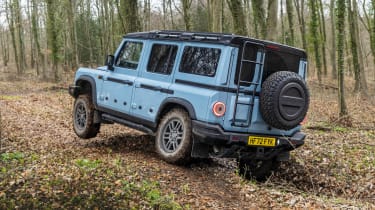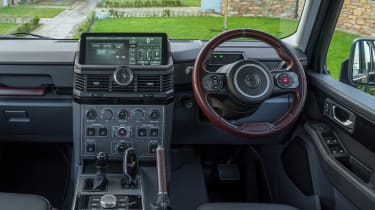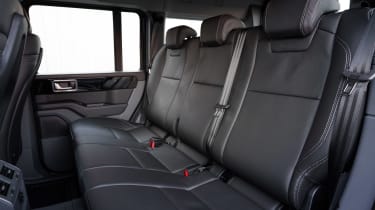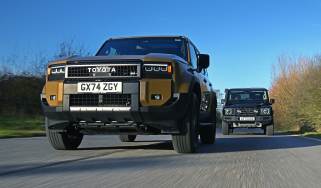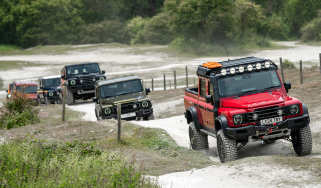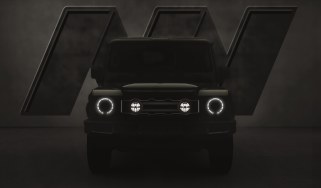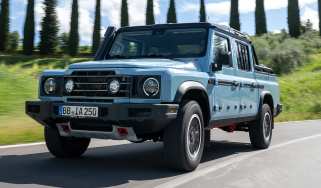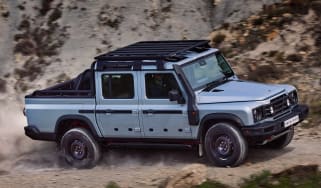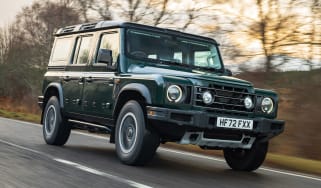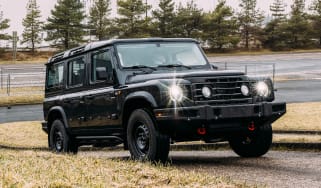Ineos Grenadier review
With echoes of the original Land Rover, the Grenadier is ready for the rough stuff

Is the Ineos Grenadier a good car?
The Ineos Grenadier was designed to be a modern-day interpretation of the classic Land Rover, and overall it fits the brief perfectly. It’s bigger in every dimension, which makes it more practical and easier to drive than its inspiration, but prices are higher than first anticipated, so this big 4x4 has some tough rivals to go up against. If all of your driving takes place off the beaten path, then the Ineos Grenadier is just about the best off-roader that you can buy, because it’s virtually unstoppable in the rough. In many ways it’s an impressive achievement for a start-up brand, because the company has produced a seriously capable off-road tool with utility and toughness built in. It’s not without its quirks, however, and as you climb the range in search of more creature comforts, you get further away from the Grenadier’s core strengths.
| Key specs | |
| Fuel type | Petrol, diesel |
| Body style | Six-door SUV |
| Powertrain |
3.0-litre, 6cyl, turbocharged, petrol, four-wheel drive 3.0-litre, 6cyl, turbocharged, diesel, four-wheel drive |
| Safety | Not tested by Euro NCAP |
| Warranty | Five years/unlimited miles |
How much does the Ineos Grenadier cost?
Prices for the Ineos Grenadier start from around £65,000, which gets you behind the wheel of the Utility Wagon – there is a cheaper option in the form of the Grenadier Commercial, but this is a tax-friendly model with only two seats and blacked-out rear windows. It starts from £52,000 (ex-VAT).
The Utility Wagon is designed with work in mind, so it has more upright seats than the Station Wagon, which is better geared to passengers and starts from around £69,000. For around £7,500 extra this model can be upgraded to Trialmaster or Fieldmaster trims that add more kit. The Trialmaster is biased towards off-road use, with extra diff locks and all-terrain tyres, while the Fieldmaster adds alloy wheels and leather trim for more luxury. Either way, you can add option packs to these two so you can have all of the kit that the other trim level comes with.
All models are powered by a choice of two BMW-sourced six-cylinder engines, one petrol and one diesel. Prices are the same for both engine options, but we’d choose the diesel for its greater torque and better fuel economy - we say better, but we should really call it less worse, because you’ll be doing well to get more than 30mpg from a 4x4 that weighs more than 2.7 tonnes.
There’s body-on-frame construction that contributes to the Grenadier’s hefty kerbweight, while the engines are connected to an eight-speed transmission and a permanent four-wheel drive system with a low-range transfer case and a central diff lock as standard. Trialmaster versions add front and rear mechanical diff locks (which are available optionally on the Fieldmaster), while the Grenadier has a suite of electronic systems that are also designed to help with off-road driving.
As well as the standard 4x4, Ineos also offers the Grenadier Quartermaster, which has a longer wheelbase and a pick-up truck load bed. It’s not a pick-up in the traditional sense because it hasn’t got a one-tonne payload, it’s more of a body variation of the standard Grenadier, and it starts from around £66,000. Ineos also offers a chassis cab version of the Quartermaster that’s designed for bespoke applications.
Engines, performance & drive
There’s a ‘Powered by BMW’ logo on the bonnet of the Grenadier, and the choice is between two of the German firm’s best six-cylinder units, either the B57 twin-turbo diesel, or the B58 turbocharged petrol. They make 249bhp and 282bhp respectively, and have 0-62mph times of 9.9 and 8.8 seconds.
The eight-speed auto is the same ZF-sourced unit that’s used by BMW – hence the lozenge-shaped drive selector sprouting from the Grenadier’s centre console – and this sends drive to all four wheels via a Tremec transfer case that offers high and low-range gears.
All versions of the Grenadier have a centre diff lock, while the Rough Pack (standard on the Trialmaster model and a £2,500 option on the Fieldmaster) adds front and rear mechanical diff locks and all-terrain tyres to optimise off-road ability.
Other parts that are outsourced include the Brembo brakes, while Eibach produces the springs and ZF the dampers for the multi-link suspension system. Unlike a Land Rover Defender, there’s no air suspension for the Grenadier, which ensures that it’s possible to repair it in the field if necessary.
The Grenadier is a chunky-looking 4x4, and there’s a Tonka Toy element to the way that it drives. Let’s get urban driving out of the way, first, because this isn’t the Grenadier’s forte. There are nearly four turns from lock to lock, and the recirculating ball set-up lacks the kind of self centring you get from a rack and pinion system, so you have to wind off any lock that you put on. Add in a large 13.5-metre turning circle, and there are big vans that are easier to navigate along city streets.
The tall driving position offers a van-like view, though, so visibility is good at the front, but limited behind by the double doors and tailgate-mounted spare wheel. There is a wide-angle reversing camera, but the feed on the main screen is small and has a low resolution.
Picking up speed is likely to take a little longer than you might like, thanks to a delay in throttle response as the gearbox kicks down a couple of ratios to make the most of the torquey six-cylinder under the bonnet. Once the motor is spooled up, the Grenadier delivers surprisingly brisk acceleration for its size and shape, and this is accompanied by a tuneful straight-six soundtrack, along with a corresponding hit to the fuel consumption.
Attacking bends is best left to cars with sharper handling. If you push the limits of the Grenadier, then the vagueness of the steering, combined with its kerbweight, shows up its shortcomings. It’s clear that the chassis is designed for off-road use first and foremost.
However, the Grenadier is a surprisingly competent long-distance machine. There’s some road noise at the motorway limit, but not a lot of wind noise considering the car’s bluff front, while the ride on all-terrain tyres doesn’t grumble at the national limit as much as it does in other cars and pick-up trucks that we’ve driven fitted with the same rubber.
The six-cylinder engines are largely unstressed when cruising, so the Grenadier is smoother than the four cylinder-equipped Toyota Land Cruiser, while the seating position is comfortable enough for a long session at the wheel – the raised left-foot rest looks like it might be awkward, but it’s fine once you’re accustomed to it.
Once you’ve experienced the ability of a Grenadier in the rough, then it’s easier to forgive its foibles on tarmac. With the addition of all-terrain tyres, the Ineos is virtually unstoppable because its diffs and electronics optimise drive in all terrain conditions. Wide approach and departure angles plus 264mm of ground clearance help, and there’s an 800mm wading depth on offer.
Selecting low-range gears via the extremely stiff second lever next to the drive shifter on the centre console seems unnecessarily physical when rivals do the same job at the push of a button, but locking the diffs via the buttons in the roof panel is simplicity in itself.
Of particular note is the hill-descent control system, which delivers smooth progress at a set speed. Attempting the same feat in most rivals will see the tyres and ABS juddering away to limit momentum, where the Ineos simply rolls along without hesitation.
| Model | Power | 0-62mph | Top speed |
| Grenadier 3.0 Station Wagon | 282bhp | 8.8 seconds | 99mph |
| Grenadier 3.0D Station Wagon | 249bhp | 9.9 seconds | 99mph |
MPG, emissions & running costs
With a pair of 3.0-litre six-cylinder engines to choose from, there isn’t really a fuel-efficient option in the Grenadier line-up. Both petrol and diesel units come with a token stop-start system, but official fuel economy figures of 19.6mpg for the petrol and 26.9mpg for the diesel are nothing to write home about. Select the Grenadier’s off-road modes and the stop-start system is deactivated, which will further impact efficiency.
The diesel will offer better efficiency and performance, but in test conditions we managed a disappointing 23.2mpg. Combine this with a huge 90-litre fuel tank and you can expect a range of around 450 miles, although we found that the car’s digital fuel gauge was very pessimistic, urging us to refuel even when the tank was only down to a quarter of its capacity. The range figure on the trip computer is a more accurate gauge of how much fuel is left.
As with other dedicated 4x4s, high emissions are par for the course with the Grenadier. It sits in the top tax bracket, and a list price in excess of £75,000 for our test car means 40 per cent taxpayers can expect annual Benefit-in-Kind bills well north of £10,000. The annual road tax bill is £620 for the first five years you pay it, too.
Insurance costs are steep, thanks to a Group 50 rating. However, Ineos is keen to point out that features such as the five-part front bumper mean that repair costs should be kept low if damage does occur.
The novelty of Ineos as a fresh brand with an all-new car has worn off slightly since launch, and residuals are now below the 50 per cent mark across the range. The diesel models offer slightly stronger figures than the petrol cars.
| Model | MPG | CO2 | Insurance group |
| Grenadier 3.0 Station Wagon | 19.6mpg | 328g/km | 50 |
| Grenadier 3.0D Station Wagon | 25.9mpg | 286g/km | 50 |
Design, interior & technology
The chunky exterior looks that are a cross between Land Rover and Mercedes’ G-Wagen are appealing, and the brutish appearance carries over to the utilitarian cabin, too.
A bank of toggle switches in the roof and the central instrument stack give the Grenadier’s cabin a functional, almost tank-like look. There’s an overload of labels for all the switches, but at least nothing is buried in the main touchscreen. There’s even a diagram overhead confirming the car’s width and height, just in case you need reminding upon entering a multi-storey car park.
As with a Land Rover Defender, the Ineos Grenadier makes a highlight of its functional cabin. The chunky switches and buttons are designed to be used while wearing gloves. In contrast, the rotary dials for the climate control and audio volume are a little shallow even for bare hands to grasp.
There are exposed screw heads on the centre console and hard plastics everywhere, while rubber floor mats and a hose-down interior (thanks to waterproof switches and controls) with drain holes demonstrate the Grenadier’s functional character.
Sat-nav, stereo and infotainment
Compared with many modern cars, the Grenadier is refreshing in its simplicity. There’s just one screen, which incorporates the car’s instruments into the section closest to the driver, while the panel ahead of the steering wheel is filled with assorted warning lights – they all illuminate like a Christmas tree when the ignition is turned on, only to disappear once you’re up and running. The iDrive-style controller on the centre console isn’t quite as positive to use as BMW’s original system, and the screen responses can be slow at times.
The screen resolution isn’t quite as sharp as some rivals’, but it shows plenty of information. There’s no built-in nav, but wireless Apple CarPlay and Android Auto are included, while the iDrive-style rotary controller and shortcut buttons help with finding your way around the display. Lots of off-road data is recorded, while the Pathfinder GPS system uses waypoints to trace routes which you can then download and share with fellow off-roaders.
Boot space, comfort & practicality
|
Dimensions | |
| Length | 4,895mm |
| Width | 1,930mm |
| Height | 2,050mm |
| Number of seats | Five |
| Boot space | 1,152 (to roof)-2,035 litres |
A boxy body offers good space inside, although cabin access could be better, and the overall packaging is slightly compromised.
Climbing aboard the Ineos is easier up front, courtesy of the large grab handles on the A-pillars. If you need improved access, we’d recommend adding the side runners (around £1,000 extra) that double as a step up into the cab.
Once you’re behind the wheel, there’s plenty of adjustment, although a large lump in the floor to the left of the brake pedal can make it awkward for some drivers to find a comfortable position, although we’ve never found it to be an issue. Storage includes medium-sized door bins and a large lockable armrest cubby, while twin cup-holders feature and there’s a narrow shelf for a phone ahead of the drive selector, although it’s easy for devices to slide out when cornering.
Once you’re in the back seats, there’s plenty of head, leg and shoulder space, and the high seating position offers a good view out. There are twin USB sockets in the back (along with two more in the central armrest cubby, both sets comprising one USB-A and one USB-C), but no air vents.
Access to the luggage area is compromised by the 30:70 barn doors. The smaller door is a bit too narrow to access the boot comfortably, while having the spare wheel hanging on the larger door means it’s heavy to open and close. Unlike some cars with barn doors, the Grenadier doesn’t have a lock on the strut to keep the door open.
The car’s tall ride height means there’s a substantial load lip, but the floor rails offer the ability to fit adjustable lashing eyes, which will be useful to tie items down to the hard plastic floor. There’s no load cover, so we’d recommend adding rear privacy glass (£455) to keep items hidden. The back seats fold in a 60:40 split, but there’s a big step up to them, so it will be tricky to load larger items safely
Safety & reliability
| Key standard safety features | Euro NCAP safety ratings |
|
|
Since Ineos is a new make, it’s difficult to judge reliability. But since many of the major components are bought in from already-established firms, this should offer some peace of mind.
Safety kit is acceptable, although the Grenadier lacks some of the very latest tech. Automatic emergency braking is now fitted to 2025 model year cars, along with road-sign recognition, but lane assist and blind-spot detection aren’t yet offered.
A five-year, unlimited-mileage warranty demonstrates that Ineos has confidence that the Grenadier will go the distance. That cover is on a par with Hyundai, and well ahead of the coverage offered by the likes of Land Rover. There’s a two-year roadside assistance package available, too.
Service intervals are every year or 12,000 miles, whichever comes first, but Ineos recommends servicing every six months or 6,000 miles if you regularly use the Grenadier in hard off-road conditions.
Ineos Grenadier alternatives
The obvious rival for the Grenadier is the Land Rover Defender, which is the reason it exists. However, these two are very different in character, with the air suspension fitted as standard to the Defender giving it a wider breadth of ability. We think the Grenadier is better off road, but the Land Rover is far less compromised on it.
Another rival is the recently revived Toyota Land Cruiser. As with the Defender, it can’t match the Grenadier off road, but is better on it. The retro-inspired looks are appealing, while the cabin has a seven-seat layout.
Other options for off-road driving include the latest crop of double cab pick-ups, such as the Ford Ranger and Volkswagen Amarok. These offer plush interiors at the top of the range, although a long wheelbase and large overhangs mean a Grenadier is still going to be more capable in the rough.
Frequently Asked Questions
To help with consumer confidence, Ineos offers a five-year, unlimited mileage warranty with its vehicles. This is also backed up by two years of roadside assistance.


